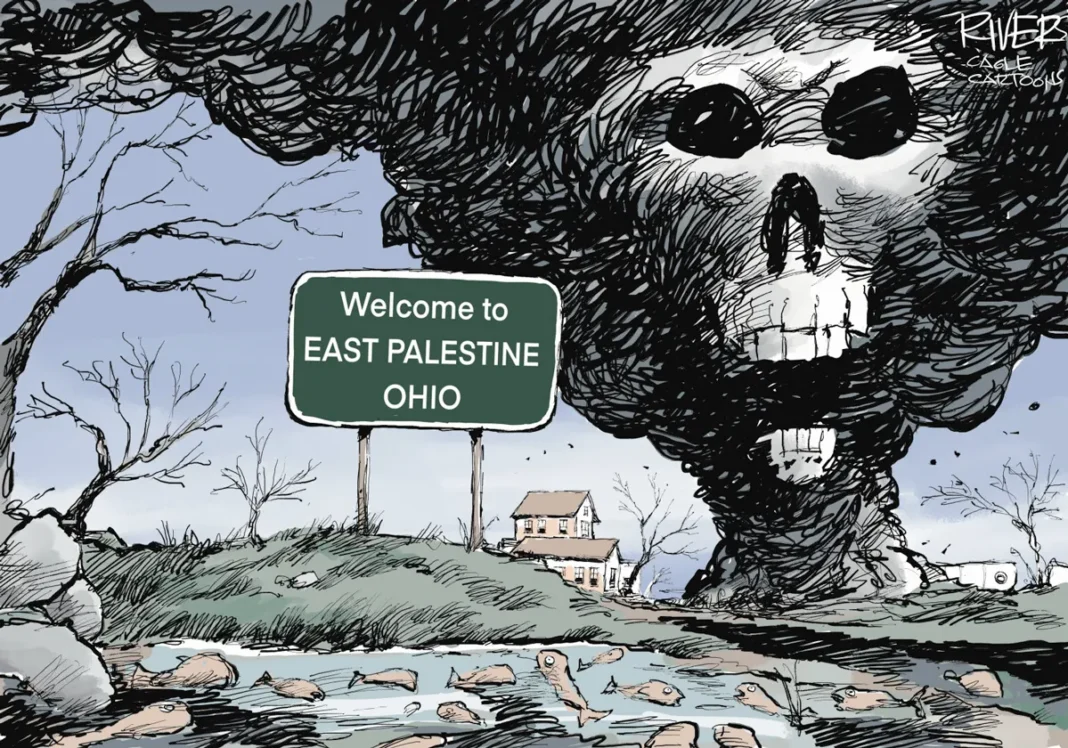As long as there have been trains there have been train derailments, they kind of go with the territory when you transport tremendously heavy loads of freight at speed over terrain, around curves, in tenuously balanced rectangular boxes perched atop thin steel rails. Add in the human factors and, well… shit happens.
That said, over the nearly two hundred years humankind has been engaged in this dodgy enterprise, certain methods and practices have been developed to at least attempt to minimize their occurrence – regimens of inspection and monitoring and practices followed in the composition and distribution of weight within the sometimes miles long ribbons of rolling potential mayhem, that have been for the most part learned the hard way, but have been ignored by some operators recently in a frenzied quest to increase profitability.
Some of the factors that might have led to the catastrophic derailment of the 32”Nasty” line on its regular route between St. Louis and Pittsburgh in East Palestine, Ohio, on February 3rd are explored in the excellent Vice Magazine article by Aaron Gordon published Wednesday of this week.
Two of the likely factors, as Aaron sees it are:
1. “Precision Scheduled Railroading” – A system designed by the rail lines to speed up the movement of freight, and thus its profitability, often at the expense of safety:
“For years, Norfolk Southern, like several other major freight rail companies, has prioritized moving trains as quickly as possible out of terminals and rail yards over safety as part of a wider move across the freight railroad industry towards a management philosophy called Precision Scheduled Railroading (PSR) intended to move more freight for lower costs. Safety inspection times and personnel have been slashed, hindering efforts to ensure trains are safe before they leave yards or terminals. Crews are dissuaded from reporting safety issues. Workers that persist in raising red flags are often ignored.”
To this layman the goal of “moving trains as quickly as possible out of terminals and rail yards” and the practice of slashing personnel needed to affect that profitable and thus desirable end would seem to be at loggerheads. After all, wouldn’t it seem that more, not fewer, workers would be needed to decrease the amount of time trains spend in the rail yards?
How Norfolk Southern solved this seeming contradiction leads us to the second likely culprit for the derailment.
2. Saving money by ignoring load distribution:
“But it is not just the overall length and weight of a train that matters for safety, but the distribution of that weight. According to the train’s load profile, confirmed by two workers familiar with 32N’s load profile and reported by the cross-union worker solidarity group Railroad Workers United, 40 percent of the train’s weight was in the rear third of the train’s length, and the back half was the heavier half. This is the opposite of long standing railroad best practice, which calls for trains to be frontloaded with the heaviest cars and the lightest at the back. But rearranging train cars takes time and manpower, both of which have been cut under PSR. As Motherboard has previously reported, trains are routinely sent onto the tracks in violation of these century-old best practices in order to save time and labor costs. The longer the train, the tricker it is to control, because cars could be in different situations; for example, the front of the train could be going downhill while the back is going uphill, according to an influential white paper written by Grady Cothen, a former Federal Railroad Administration safety official on the dangers of long trains under PSR…
…If the heavier load is at the back, trains experience unintuitive and dangerous dynamics, especially during braking. The heavy cars at the back will push against the lighter ones in the front. In extreme scenarios, those forces can be so high that they push cars up and off the rails, resulting in derailment. If a derailment happens, heavier cars plowing in will be more likely to result in explosions and ruptured tankers due to the extra force.
Due to the nature of the cargo 32N routinely picks up, and the order in which it is picked up, 32N has developed a reputation among Norfolk Southern employees, according to Whitaker and the two employees familiar with 32N. It is typically long and heavy at the back, the trickiest kind of train to run. Before PSR, railroads would take the time to re-arrange the cars of a train to ensure the heavier cars were towards the front. Now, with an emphasis on speed and profitability, they often don’t, according to the two workers. This is how 32N earned the nickname “32 Nasty.”
Of course, as Aaron reports in his article, Norfolk Southern has already, even ahead of the the final report on the derailment, stated that no decrease of personnel, paring down of safety inspections or load distribution issues factored in the derailment.
All the more reason for the reporting agencies to look into those factors, I say.
Aaron Gorman’s reporting is excellent and exactingly thorough, unlike this meager summary.
If you are interested in the subject I highly recommend you read it.




















